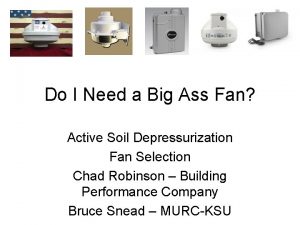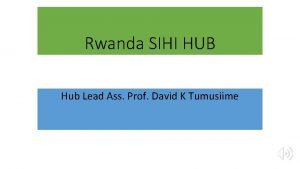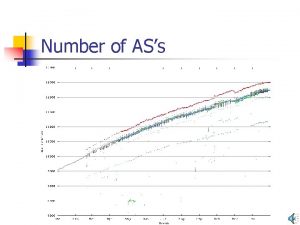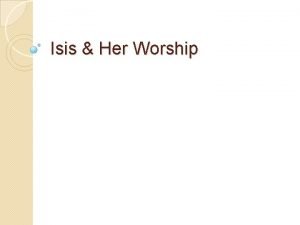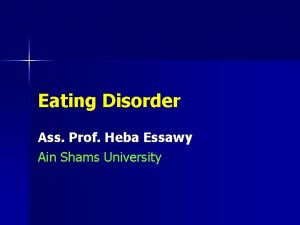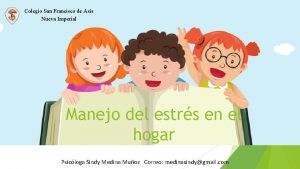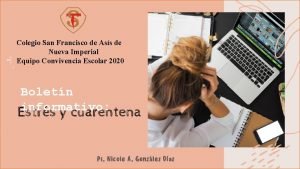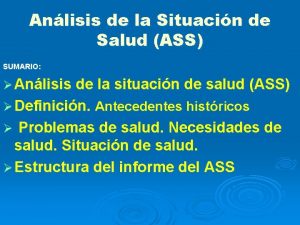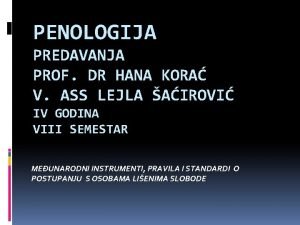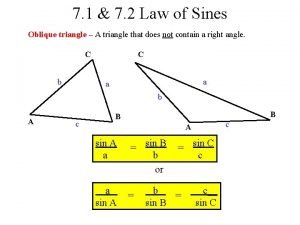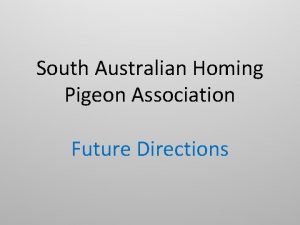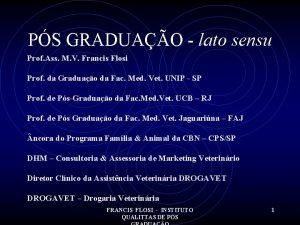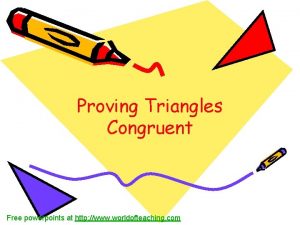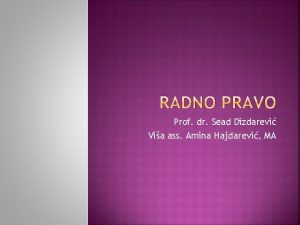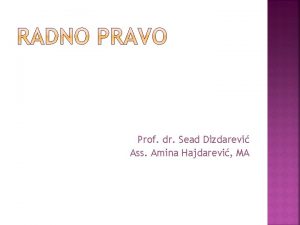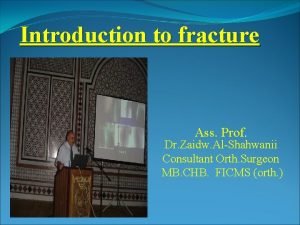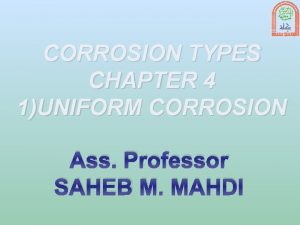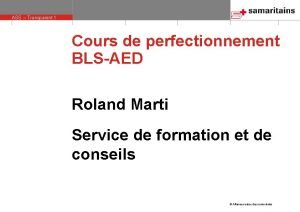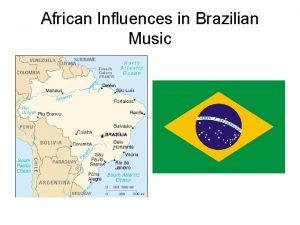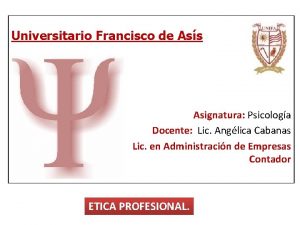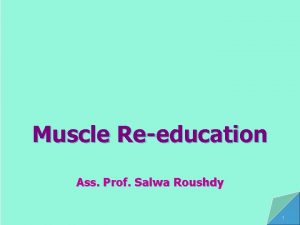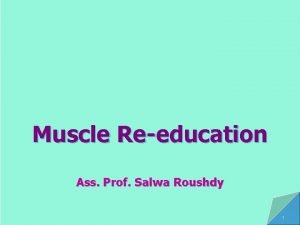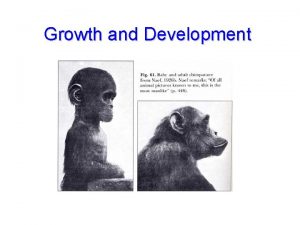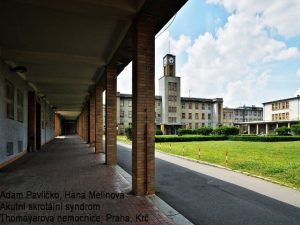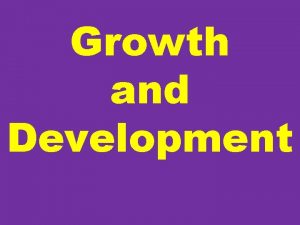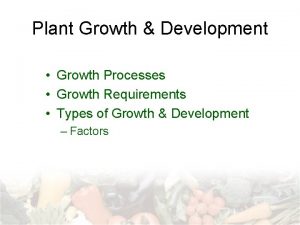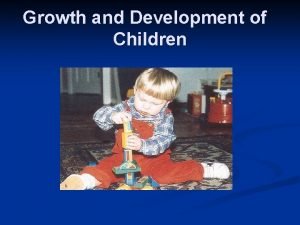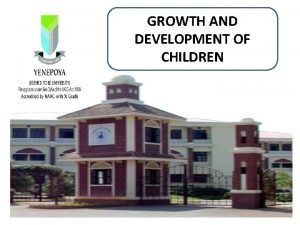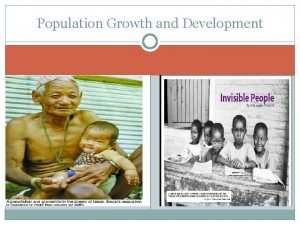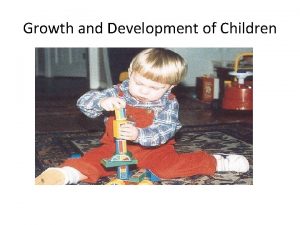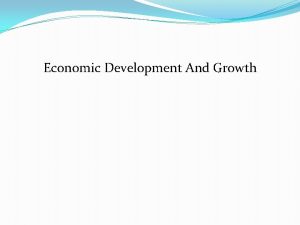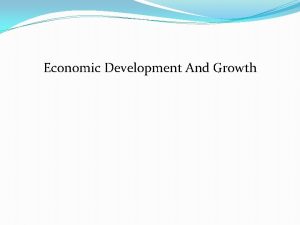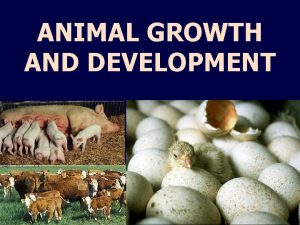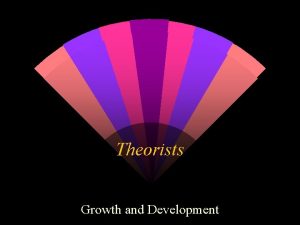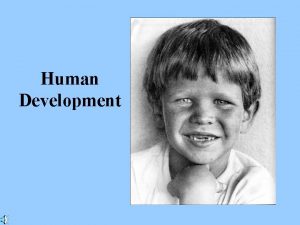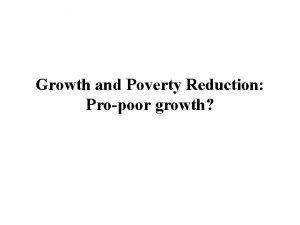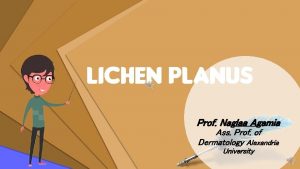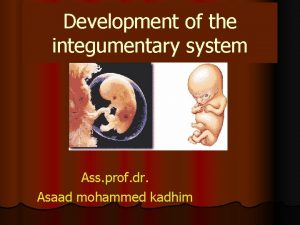Lecture 1 GROWTH AND DEVELOPMENT Ass Prof Dr

































- Slides: 33

Lecture 1 GROWTH AND DEVELOPMENT Ass. Prof. Dr. Marwa M. Ibrahim 1

Lecture Objectives By the end of this lecture, the student will be able to: -Differentiate between Growth and development. -Know to the characteristics of normal newborn baby. - Understand memorize the principles of development. - Recognize the reflexive maturation. - Classify the reflexes. 2

GROWTH AND DEVELOPMENT • It is useful for physical therapist working with children to study the various aspects of growth and development as well as reflexive maturation at different phases in the life. • Satisfactory development requires a well-formed and normally functioning nervous system. An environment provides appropriate and adequate nutrition at all stages, opportunities to learn and act. 3

Phases of Development: • Prenatal: From conception to birth (280 days). • Neonatal: From birth up to the 4 weeks of age. • Infancy: The first 2 years of life. • Early childhood: From 2 to 6 years. • Middle childhood: From 6 to 12 years. • Late childhood (Adolescence): From 12 to 18 years. 4

• Characteristics of Normal Newborn Baby: – Full term baby (from 38 to 40 weeks gestational age). – Free of congenital defects or obstetric damage. – Weights between 3 to 4 kg with head circumference between 34. 1 and 35. 8 cm. – Breaths spontaneously and cries lustily (in a strong, healthy, vigorous way ) soon after delivery. – Rapidly develops an overall healthy pink color with a heart rate between 100 and 140 beats/minute. 5

• Characteristics of Normal Newborn Baby (cont. ): – Responds by movements to gentle noxious stimulus. – Has good tone of the skeletal muscles with the limbs well flexed. – In supine, the baby turns the head to one side with arms and legs flexed. – In prone, the baby lies with knees drawn up under the abdomen with the pelvis high. – In vertical suspension with the physical therapist's hand under the baby's abdomen, the head hangs down. 6

Growth • Growth is a quantitative change in behavior. It involves a series of anatomical and physiological changes that alter the body's size and composition. • Different parts of the body grow at variable rates. The brain, whose growth and maturation is most closely related to the development of the human behavior, grows more rapidly during the prenatal period than at any other time during life span. Tissues that are involved in reproductive function grow most rapidly at puberty. The bony epiphysis closes at different ages. • Growth does not cease once maturity is reached. If this was so, there would be no healing of bone after a fracture or repair of wounds of skin and muscles. 7

1 - Weight: • At birth: 3 to 4 kg. • During the first 4 months: About 750 gm per month. • During the second 4 months: About 500 gm per month. • During the third 4 months: About 250 gm per month. • During early childhood: About 2 kg per year. • During late childhood: About 2. 5 kg per year. 8

2 - Height: At birth: 50 cm. At 2 years: 87 cm. At 6 months: 68 At 3 years: 94 cm. At one year: 75 At 4 years: 100 cm. • Between 4 and 8 years, height increases about 7 cm per year. • Between 8 and 12 years, height increases about 5 cm per year. 9

3 - Head Circumference: 10 At birth: 35 cm. At 2 years: 49 cm. At 6 months: 43 cm. At 6 years: 51 cm. At one year: 47 cm. At 12 years: 53 cm.

Development Definition: • It is a qualitative change in behavior. It is a continuous dynamic process of unfolding and elaboration of behavior, which results from the interaction between the human organism and the environment. Development proceeds stage by stage in an orderly sequence despite individual variation. 11

Principles of Development: 1. It is a continuous process from conception to maturity. 2. It depends primarily on the maturation of the nervous system. 3. The sequence of development is the same for all children but the rate varies from a child to another. 4. It is cephalocaudal and proximodistal in direction. 5. It involves differentiation of behavior. There is a gradual change of behavior from relatively repetitive and stereotyped form to more elaborated one. 12

6 - Generalized mass activity gives way to specific individual responses (e. g. ; newborn responds with a crude grasp reflex to stimulation of his palm then with development, he develops mature grasp and release). 7 - Some motor skills like grasp and walking have their foundation in reflex equivalents that were present at birth. As the brain matures and the cortex assumes more and more control, the reflexive behaviors are replaced by voluntary and purposeful versions of those activities. 8 - Different aspects of development depend upon certain basic factors including head control, extension against gravity, symmetry, breakup of primitive pattern of movement and the development of postural reactions. 13

Steps of Myelination: • Myelination of the nervous system starts by the 4 th fetal month. • At birth: – All cranial nerves are myelinated except olfactory and optic nerves. – Autonomic nervous system is mature. – All sensory receptors for pressure, pain and temperature are myelinated. • At 2 years: The spinal cord, brainstem and cerebellum. • At 3 years: Peripheral nerve roots. • At 5 years: All structures of the peripheral and central nervous systems. 14

LANGUAGE Development 1 month – alerts to sound 3 month – coos ( musical vowel sounds) 4 months – laugh aloud 6 months – monosyllables (ba- pa –da), ah- goo sounds • 9 months – bisyllables (mama, baba, dada) • 12 months – 1 -2 words with meaning • •

VISION Development • 1 month – baby can fixate on his mother as she talks to him • 3 -4 months : child can fixate intently on an object shown to him (grasping with eye) • 6 weeks : binocular vision begins and is well established by 4 months • 6 months : child adjusts his position to follow object of interest • 1 year : follow rapidly moving objects

HEARING Development • 3 -4 months : child turns his head towards the source of sound • 5 -6 months : child turns the head to one side and then downward if a sound is made sound below the level of ears. • 10 months : child directly looks at the source of diagonally

Reflexive Maturation • The neonate exhibits a number of reflexes that demonstrate the activity of the neonate's CNS and provide the basis for later motor development. As the infant grows, the reflexes become more complex to allow further motor development as the CNS develops. • As the CNS develops, many of the early reflexes are inhibited and others are modified and incorporated into more complex actions. These changes are necessary because continued activities of the early reflexes would interfere with the development of other actions (i. e. ; the primitive reflexes are controlled and inhibited at certain age so that higher righting and equilibrium reactions become apparent). 18

Definition of Terms: • Reflex: Specific automatic patterned motor response that is induced by a particular stimulus and does not involve any voluntary conscious control. • Primitive Reflexes: Spontaneous and stereotyped responses to a specific stimulus. They are present at birth and are inhibited as a result of CNS maturation. • Automatic Reflexes: Reflexes that are not present at birth but evolve during the first 2 years of the infant's life. 19

Postural Reactions: 1 -Righting Reactions: Group of automatic reactions that assist in maintaining the posture of the head, trunk, arms and legs in proper relationship to one another and to gravity. They give man the head control and rotation within the body axis. 2 -Protective Reactions: Responses that are activated by rapid changes in body position stimulating a fall and are characterized by movements of the extremities in an attempt to break the fall. 3 -Equilibrium Reactions: Set of reactions that are more complex and of higher integration within the CNS. They are stimulated by slow change in the body position and they produce compensatory shifts of tone to maintain or restore balance. 20

Importance of Reflexes: • They influence the child's development, as the reflex integration is essential in normal development. Response to the reflexes prepares the infant for progressive development such as rolling, sitting, …. etc. • They provide useful diagnostic sign. (the reflex indicates abnormality by their weakness, absence, excessive strength or persistence in an inappropriate age). • They could be used therapeutically (e. g. ; postural reactions are stimulated and used to promote the upright position). 21

Classification of Reflexes: – According to time of their appearance: such as primitive reflexes. – According to the level of the CNS maturation: into spinal, brainstem, midbrain and cortical reflexes. – According to the type of stimulus: such as; • • Reflexes respond to pressure and pain (withdrawal reflex). Reflexes respond to kinesthetic stimuli (TNR, Moro reflex). Reflexes respond to visual stimuli (optical righting reactions). Reflexes respond to labyrinthine stimuli (tonic labyrinthine reflex). – According to their relation to normal sequence of motor development into: • Apedal reflexes (primitive and brainstem reflexes). • Quadrupedal reflexes (midbrain level reflexes). • Bipedal reflexes (cortical level reflexes). 22

1 - Spinal Level Reflexes: • These are phasic or movement reflexes, which coordinate muscles of the extremities in patterns of either total flexion or extension. • They may be present in normal child within the first two months of life. • Persistence beyond two months of age indicates delayed CNS maturation. • Complete domination by these primitive spinal reflexes results in an apedal (prone and supine) creature. • They are: - Flexor withdrawal reflex. - Crossed extension reflex. 23 - Extensor thrust reflex.

2 - Brainstem Level Reflexes: These are static reflexes that cause changes in distribution of muscle tone throughout the body in response to a change of either: • The position of the head and body in space (by stimulation of the labyrinthine). Or, • The position of the head in relation to the body (by stimulation of the proprioceptors of the neck region). • They may be present in normal child within the first four to six months of life. • Persistence beyond six months of age indicates delayed CNS maturation. • Complete domination by these primitive brainstem reflexes results in an apedal (prone and supine) creature. 24

They are: Reflex Age of Appearance - Asymmetrical tonic neck reflex. Birth to 4 or 6 months. - Symmetrical tonic neck reflex. Birth to 4 or 6 months. - Tonic labyrinthine reflex Supine. Birth to 4 months. - Tonic labyrinthine reflex prone. Birth to 4 months. - Positive supporting reaction. Three to 8 months. - Negative supporting reaction. 8 months and continues 25

3 - Midbrain Level Reflexes (Righting Reactions): • Righting reactions interact with each other for the establishment of normal head and body relationship in space as well as in relation to each other. • These are the first reactions to develop after birth and reach maximal concerted effect about age 10 to 12 months. • As cortical control increases, they are gradually modified and inhibited then disappear towards the end of the fifth year. • Their combined actions enable the children to roll over, sit up, get on their hands and knees and make them a quadrupedal creature. 26

They are: Reflex Age of Appearance - Neck righting reaction. Birth to 6 months. - Body righting acting on body. Six to 18 months. - Labyrinthine righting acting on One or 2 months ~» throughout life. head: Prone - Labyrinthine righting acting on Six months ~» throughout life. head: Supine - Labyrinthine righting acting on Six or 8 months ~» throughout life. head: Side lying right - Labyrinthine righting acting on Six or 8 months ~» throughout life. head: Side lying left 27

Reflex Age of Appearance - Optical righting acting on head: Two months ~» throughout life. Prone - Optical righting acting on head: Six months ~» throughout life. Supine - Optical righting acting on head: Six or 8 months ~» throughout life. Side lying (right ) - Optical righting acting on head: Side lying (left) Six or 8 months ~» throughout life. - Amphibian reaction. Six months ~» throughout life. 28

4 - Cortical Level (Equilibrium) Reactions: • Maturation of the equilibrium reactions brings the individual to the human bipedal stage of motor development. • They occur when muscle tone is normalized and provide body adaptation in response to change in center of gravity of the body. • They emerge from six months on and are mediated by the efficient interaction of cortex, basal ganglia and cerebellum. 29

They are: Position of the Reaction Age of Appearance - Supine. Six months ~» throughout life. - Prone. Six months ~» throughout life. - Four-foot kneeling. Eight months ~» throughout life. - Sitting. Ten or 12 months ~» throughout life. - Kneel-standing. Fifteen months ~» throughout life. - Hopping in different directions. Fifteen or 18 months ~» throughout life. - Dorsiflexion reaction. Fifteen or 18 months ~» throughout life. 30

Automatic Movement Reactions: These are a group of reflexes observed in infants and young children, which are not strictly righting reactions but are reactions produced by changes in the position of the head and hypothetically, involve either the semicircular canal, labyrinthine or neck proprioceptors. 31

They are: Reflex Age of Appearance - Moro reflex. Birth to 4 months. - Landau reflex. Six months to 2 or 2½ years. - Protective extensor thrust (parachute reaction). Six months to throughout life. 32

THANK YOU…
 Big asd fans
Big asd fans 01:640:244 lecture notes - lecture 15: plat, idah, farad
01:640:244 lecture notes - lecture 15: plat, idah, farad Relative growth rate equation
Relative growth rate equation Shoot system
Shoot system Primary growth and secondary growth in plants
Primary growth and secondary growth in plants Chapter 35 plant structure growth and development
Chapter 35 plant structure growth and development Step growth polymerization vs chain growth
Step growth polymerization vs chain growth Geometric vs exponential growth
Geometric vs exponential growth Neoclassical growth theory vs. endogenous growth theory
Neoclassical growth theory vs. endogenous growth theory Organic vs inorganic growth
Organic vs inorganic growth Esposa ass
Esposa ass Rwanda ass
Rwanda ass Nn model ass
Nn model ass Señora ass
Señora ass Latin ass worship
Latin ass worship Anorexic ass
Anorexic ass Colegio san francisco de asis nueva imperial
Colegio san francisco de asis nueva imperial Colegio ass
Colegio ass Pokemon my ass rom hack
Pokemon my ass rom hack Ass salud
Ass salud Kora ass
Kora ass Clara brasil ass
Clara brasil ass Oblique triangle
Oblique triangle South australian homing pigeon
South australian homing pigeon Lattos ass
Lattos ass Ass postulate
Ass postulate Sead dizdarevic profesor
Sead dizdarevic profesor Ass amina
Ass amina Zaidw
Zaidw Ass
Ass Ass transparent
Ass transparent Brazilian ass slave
Brazilian ass slave Ass lic
Ass lic Ass do mar
Ass do mar
